Green Knowe: Ghost Children and Christian Folklore
A house surrounded by flood and inhabited by ghost children. Whispers on the stairs. A toy horse rocking by itself. Plague deaths. Legs blown off in war. Demon trees... This twee book for children is sounding like a spectral children’s companion to the Woman in Black. It is The Children of Greene Knowe.
(SPOILERS: There may be accidental spoilers of the following books – The Children of Green Knowe; Tom’s Midnight Garden; Moondial)
“Tomorrow shall be my dancing day…To see the legend of my play.”
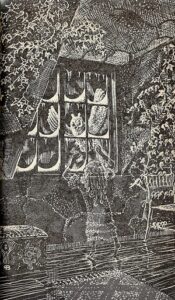 In 1954 Lucy Boston wrote a children’s book to make some quick money; the result is very twee, very dated and full of childhood innocence. It is very much the book it intends to be: the possibilities of supernatural otherness is meant to be taken in the stride of both reader and seven year old Tolly. Ghosts may be a lonely boy’s dreams or imagination but are very real to Tolly and his grandmother. Real, hundreds of years old and delightful playmates in games of hide and seek.
In 1954 Lucy Boston wrote a children’s book to make some quick money; the result is very twee, very dated and full of childhood innocence. It is very much the book it intends to be: the possibilities of supernatural otherness is meant to be taken in the stride of both reader and seven year old Tolly. Ghosts may be a lonely boy’s dreams or imagination but are very real to Tolly and his grandmother. Real, hundreds of years old and delightful playmates in games of hide and seek.
And yet, reading it as an adult, the experience of so many darker ghost stories has either tainted the innocence of this book or drawn out what lies beneath. There is a horse rocking by itself. The voice of an unseen mother sings a 400 year old lullaby. A crying, lonely, seven year old wishes he could join the ghosts.
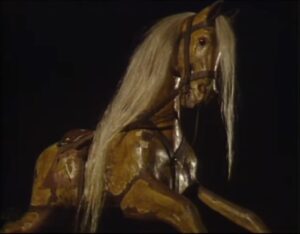
BBC Green Knowe Title Screen
Ghosts as childhood friends is a similar theme to children’s timeslip books like 1950s Tom’s Midnight Garden and 1980s Moondial. All three were also turned into BBC TV series in the 1980s. Green Knowe on TV presents a slightly irritating version of Tolly, a not inaccurate portrayal of him from the book. If written today the guileless Tolly would probably have more bite, but this naivety of style is what can make the substance so unsettling as an adult reader, at least in the book. Moondial’s almost folk horror moments possibly reflecting the changes that took place from the late 1950s as the James Frasier/Margaret Murray ideas of a pagan folklore came to the popular cultural fore, whether due to the popularity of Gerald Gardner’s Wicca or the general zeitgeist, who knows? The 1950s can seem like a turning point with a more foreboding set of children’s books from Alan Garner and Susan Cooper (The Weirdstone of Brisingamen and The Dark is Rising) surfacing to reflect this.
Both Green Knowe and Tom’s Midnight Garden have a number of similarities: both set in the country near Cambridge, both based around houses that actually exist (Green Knowe’s being one of the oldest inhabited houses in the UK and where Lucy Boston lived, imagined and wrote her stories) both finishing at winter/Christmas and both incorporating christian symbolism easily in their tales.
“This poor youngling, for whom we sing..”
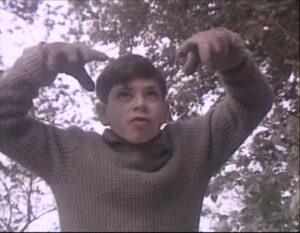
BBC Green Knowe's Tolly
Tom’s Midnight Garden incorporates the Book of Revelation and Ely Cathedral but Green Knowe absolutely drips with christian folklore, again possibly reflecting popular culture before it went full pagan folklore. Allusions to The Flood, the Ark and Noah are writ large from page one. In fact, they are not allusions but integral and stated. Magic and story builds to Christmas eve, there are dreams at Midnight Mass and a repetition of Christmas Carols. ‘The Holly and the Ivy,’ sits with ‘Tomorrow shall be my Dancing Day’ (the carol that inspired ‘Lord of the Dance’) and ties in nature to christian myth as much as the birds and animals that are a part of the garden and book are tied to Noah’s Ark.
St Christopher, as statue and presence, stands in the literal shadows of house, church and story. St Christopher’s popularity in the UK from the middle ages to only a few decades ago is reflected in the paintings of him as a giant on walls of old churches across the land. As saint of travellers, Saint Christopher necklaces were ubiquitous even relatively recently. If you were travelling abroad or away, to be given a ‘St Christopher’ was about as common as getting travel directions and cautions to not drink the water.
Old prayer ditties, ‘Mathew, Mark, Luke and John; bless this bed that I lie on,’ are also part of the weaving of song and layers into the story along with ghostly lullabies, a masque where the old are enamoured while lovers shot dead and a chanting spell-song to the Demon Tree. This song itself given history in a ‘Quatermass and the Pit’ style revelation.
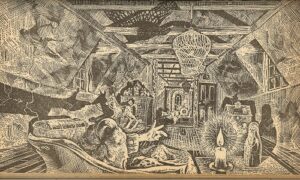
Book Illustration by Peter Boston
This constant layering is referenced blatantly in the description of mirrors in mirrors, dolls in dolls and shadows of shadows. Knowe is itself Noah, name of house and tree and inhabitants: Green Knowe, Green Noah, Old Noah, OldKnow. All as interchangeable and intermingled as the names of the living and the dead and their relation to each other. What should be a complete confusion is relayed so matter of factly in the innocence of a 1950s children’s story that the Grandmother talking in the present tense about things that happened hundreds of years ago is completely as it should be. It also reminded me of hearing history relayed by old guys I worked with in the countryside when I was a lot younger.
The story as a whole may be woven with many threads but all of the pattern seems to be on display, it doesn’t feel as if there are any hidden designs. Some of the stitches might be a ghost girl saying ‘I’m dead’ or someone recounting their grandson’s legs being blown off but in no greater fashion than when they talk of putting sugar in their tea. I might be erroneously trying to fit it alongside stories like MR James Lost Hearts when it is actually exactly what it appears: a children’s book from the early 1950s from an author steeped in her time. Whatever the case, I have read The Children of Green Knowe three times this year and watched the TV series twice and I still don’t quite know what it is. A very dated children’s story or an unsettling multi-layered haunting.
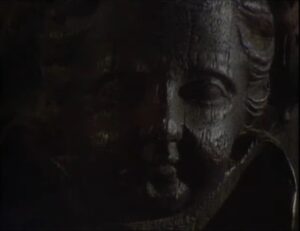
BBC Green Knowe Credits Screen